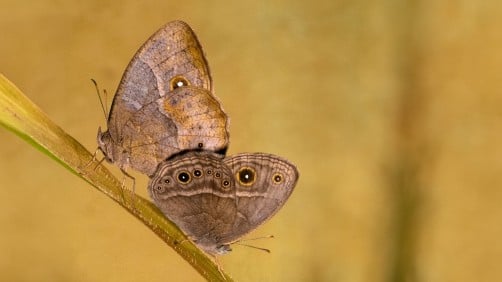Science
Tropical Butterflies Use DNA Switch for Seasonal Wing Changes

Scientists at the National University of Singapore (NUS) have identified a crucial DNA “switch” that enables tropical butterflies to modify their wing patterns in response to seasonal temperature variations. This discovery, published on October 24, 2025, in the journal Nature Ecology & Evolution, enhances the understanding of how environmental factors influence evolutionary adaptations in insects.
The research focused on the Bicyclus anynana, a species of butterfly known for its remarkable seasonal color changes. In the wet season, these butterflies exhibit larger eyespots on their wings, while during the dry season, the eyespots shrink. This ability to change wing patterns is a form of seasonal plasticity, which aids in survival by allowing the butterflies to adapt to varying environmental conditions.
Professor Antónia Monteiro, who led the study, emphasized that the visual differences in tropical butterflies are striking, depending on the season they emerge. Earlier studies indicated that the temperature experienced by caterpillars influences the size of these eyespots. The current research builds on those findings by identifying a specific gene responsible for this trait.
The team pinpointed a master control gene called Antennapedia (Antp), which regulates the development of eyespots in satyrid butterflies. The researchers discovered that the activity of this gene fluctuates based on the temperature at which the butterflies are raised. Disruptions to the gene’s activity resulted in reduced eyespot size, particularly under warmer conditions, thereby confirming its pivotal role in seasonal adaptation.
In an important advancement, the study revealed a previously unknown DNA switch, or “promoter,” that is unique to satyrid butterflies. This switch activates the Antp gene specifically in the cells responsible for eyespot formation. When the switch was disabled, the butterflies’ capacity to adapt their eyespot size with temperature diminished, highlighting the genetic element’s significance in their evolutionary flexibility.
Dr. Tian Shen, the paper’s lead author, noted the implications of their findings. “It is striking that a simple genetic switch can underlie complex environmental sensitivity across a broad group of insects,” he stated. This research not only sheds light on the mechanisms behind seasonal adaptability but also opens avenues for future studies aimed at understanding how such genetic switches contribute to evolutionary processes.
As climate change continues to pose challenges for many species, insights from this research could inform conservation efforts designed to support the adaptation of wildlife to rapidly changing environments. The ability of insects like the Bicyclus anynana to respond to seasonal shifts provides a fascinating glimpse into the complexities of nature’s adaptability.
The study signifies a major step forward in the field of evolutionary biology, offering a clearer picture of how specific genetic factors influence the ability of organisms to thrive in diverse conditions. The work done by the NUS team underscores the importance of genetic research in the context of global environmental changes.
-

 World1 week ago
World1 week agoMass Production of F-35 Fighter Jet Drives Down Costs
-

 World1 week ago
World1 week agoGlobal Air Forces Ranked by Annual Defense Budgets in 2025
-

 Top Stories1 week ago
Top Stories1 week agoDirecTV to Launch AI-Driven Ads with User Likenesses in 2026
-

 Science1 week ago
Science1 week agoTime Crystals Revolutionize Quantum Computing Potential
-

 World1 week ago
World1 week agoElectrification Challenges Demand Advanced Multiphysics Modeling
-

 Top Stories1 week ago
Top Stories1 week agoNew ‘Star Trek: Voyager’ Game Demo Released, Players Test Limits
-

 Entertainment1 week ago
Entertainment1 week agoFreeport Art Gallery Transforms Waste into Creative Masterpieces
-

 Lifestyle1 week ago
Lifestyle1 week agoDiscover Reese Witherspoon’s Chic Dining Room Style for Under $25
-

 Lifestyle1 week ago
Lifestyle1 week agoLia Thomas Honored with ‘Voice of Inspiration’ Award at Dodgers Event
-

 Health1 week ago
Health1 week agoGavin Newsom Critiques Trump’s Health and National Guard Plans
-

 Entertainment1 week ago
Entertainment1 week agoFast & Furious Coaster Hits the Track at Universal Studios
-

 Science1 week ago
Science1 week agoWaning Crescent Moon: What to Expect on October 17









